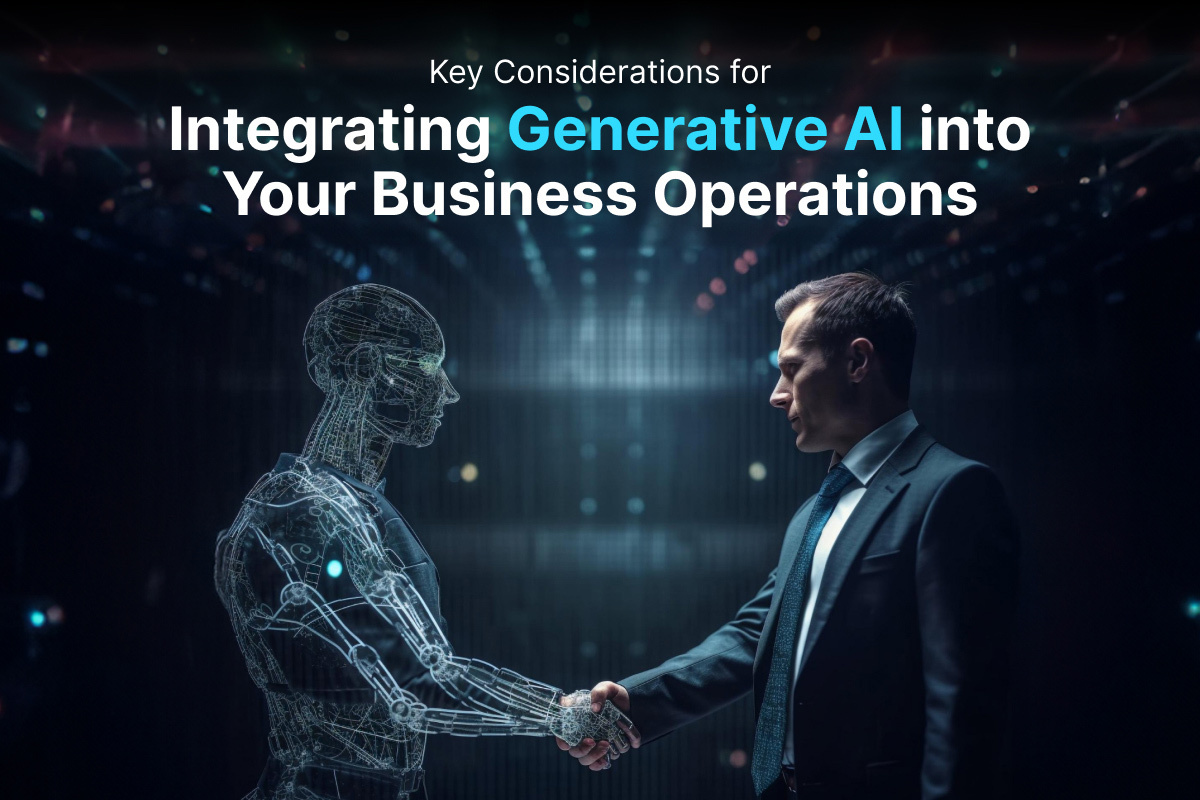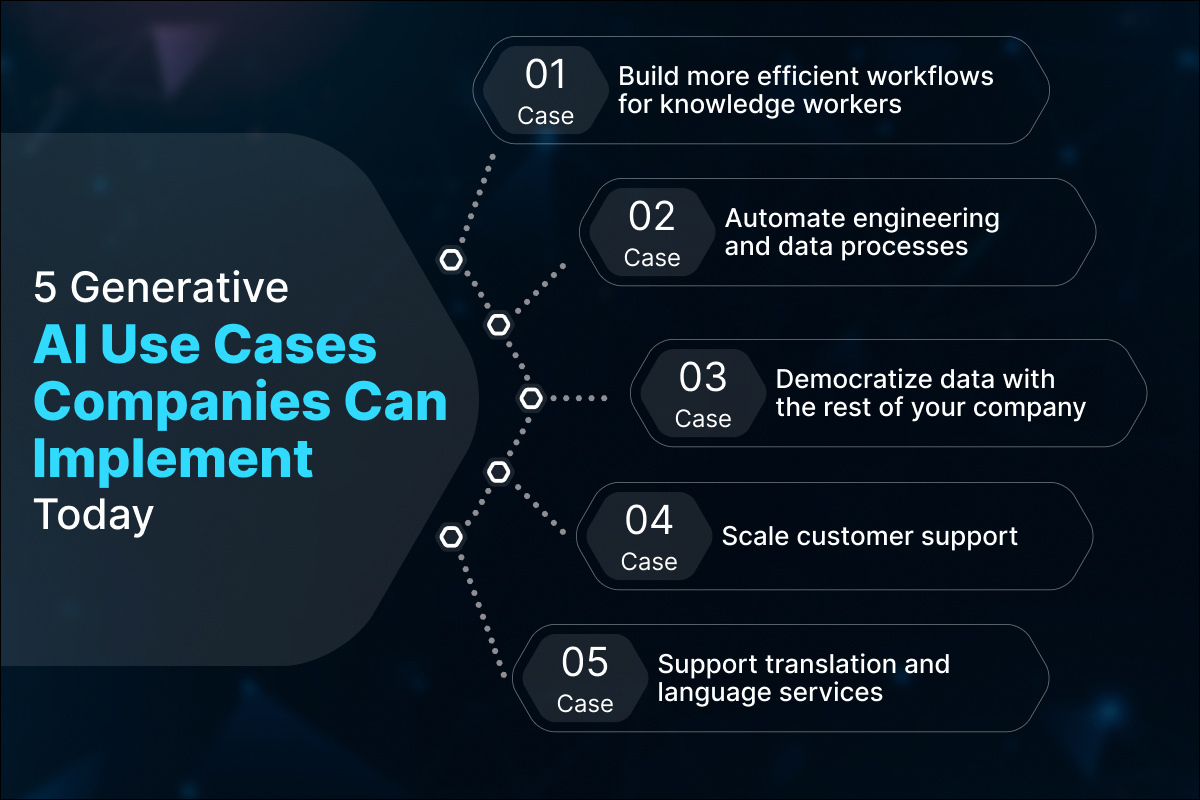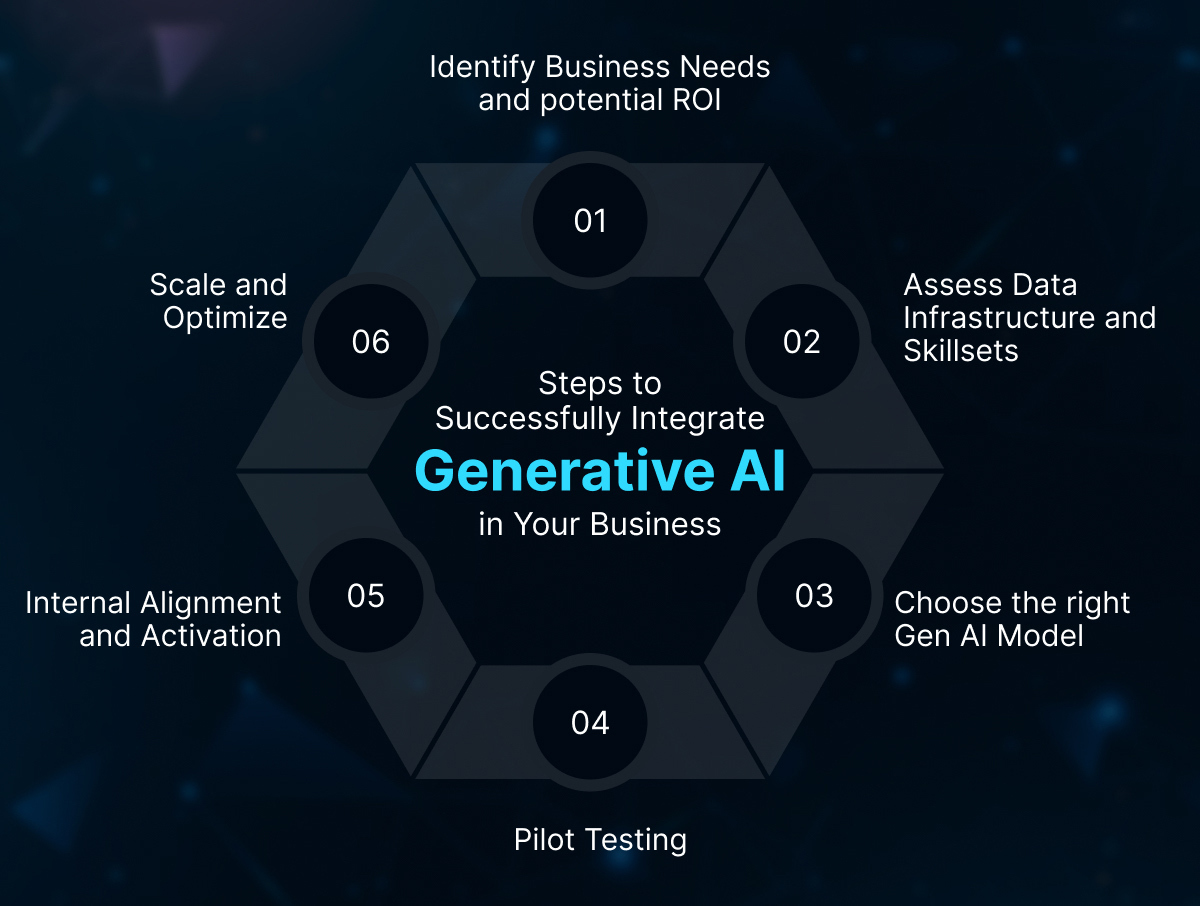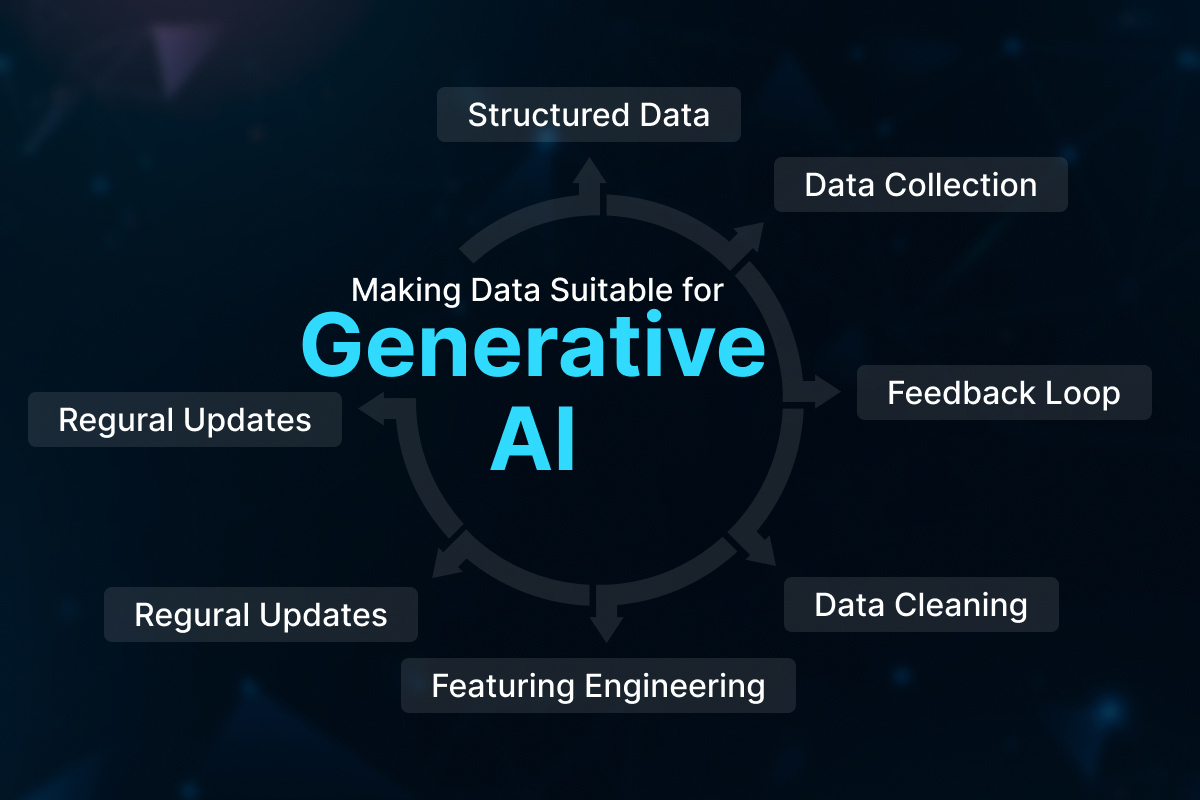Things to Look Out for While Implementing Generative AI in Your Business Processes

Generative AI is bringing about a significant transformation across industries. It is reinventing the processes across these industries, utilizing its remarkable ability to generate new and original content. Take the pharmaceutical industry for example. Companies generally utilize a painstaking, manual process to sort through countless molecules to find a single life-saving drug. However, generative AI is changing that, thus revolutionizing drug discovery. AI systems can analyze extensive chemical libraries, identify promising molecules with disease-fighting properties, and even predict their interaction with the human body – all in a fraction of the traditional time and cost.

This is just one example of what is generative AI and what it brings to the table. And if you’re curious about how it works; simply put, it works by taking existing data – text, images, code, etc. – and using it to generate entirely new forms of data.
Businesses can draw substantial benefits by implementing generative AI in their processes. They can optimize content creation to generate personalized marketing copies or product descriptions, automate repetitive tasks to free up resources and have them focus on higher-level strategic tasks, and even generate fresh product designs that are both functional as well as sustainable.
However, businesses should not just begin experimenting with generative AI tools just like that. As with any powerful technology, careful considerations and due diligence are extremely essential. The potential benefits are undeniable, no doubt! But the challenges and limitations are real as well. Businesses cannot overlook crucial factors like data security and data privacy, among others.
Sure, in order to gain a competitive edge and fast-track growth, businesses should look to implement generative AI into their processes as fast as possible but they need to consider some key factors to ensure thoughtful and careful integration. We’ll discuss these factors in detail in the subsequent sections of this article. So stay tuned!
Identifying the Right Use Case
Generative AI is a transformative technology, however, it is crucial to identify the right use case to ensure successful implementation. It is critical to figure out an application or project where generative AI can deliver the maximum value to your business. So, how do you find that perfect fit? The ideal method is to consider the following three factors.
Value Proposition
The first step is to pinpoint areas where generative AI can significantly boost operations, customer experience, content creation, or task automation. For instance, analyze if it can personalize customer experiences by drafting targeted marketing messages or chat support responses. Or if it can automate repetitive tasks like report generation or data analysis, thereby freeing up your team for more strategic work. Alternatively, you can also identify a value proposition that generative AI can support creatively by helping you generate new product ideas or marketing campaigns that not only catch the audiences’ eyes but also delight them.
Feasibility Check
After identifying high-value opportunities, the next step is to assess if your company is ready for generative AI implementation. Here readiness implies in terms of infrastructure, data, and expertise. For instance, it is essential to check if your company possesses the necessary computing power and storage capacity to handle AI models. Furthermore, having access to high-quality data that is relevant to your chosen use case is critical as well. This is because it is essential to have a sufficient amount of clean data for generative AI to function efficiently. Finally, you must also consider your team’s expertise. While some solutions offer user-friendly interfaces, integrating complex generative AI models might require additional training or external support.
Balancing Risk and Reward
Generative AI is a relatively newer technology that doesn’t come without challenges. It's crucial to consider the potential impact on stakeholders, especially your employees. You must beware that generative AI doesn’t replace human expertise entirely while utilizing it for task automation. The goal is to complement and add to your team’s capabilities and diminish them.
Then there is data security and data privacy. It is important to make sure that you implement generative AI adhering to relevant regulations and protecting sensitive information. Furthermore, AI models often generate responses containing biases arising from the data they are trained on. So it is vital to be mindful of them and implement strategies to eliminate them in order to get fair and ethical results.
Now as we just established, it is imperative to implement generative AI carefully and thoughtfully, businesses across different industries are already tapping into the technology’s incredible potential.
In the finance sector, generative AI is creating personalized financial reports for customers. Manufacturing companies are using generative AI to optimize product design and optimize production processes. These are just a few examples that depict the remarkable versatility of this technology.
Data Considerations for Generative AI
Data is at the core of the generative AI technology. It is what runs the “machine”. The quality and quantity of data can directly influence the success of your implementation.
Data Quality and Quantity
Generative AI models learn by analyzing huge amounts of data. The cleaner and more accurate the data is, the better the model will perform. Simply put, the quality of this data directly impacts the quality of the AI's outputs. If you feed a model with inaccurate or incomplete data, it will generate outputs that are equally flawed. Techniques like identifying and correcting errors, removing inconsistencies, and filtering out irrelevant information are essential for preparing your data for AI training.
But quality isn't the only factor. Generative AI models often require a substantial amount of data to function effectively. If your chosen use case involves generating realistic images, for example, you'll need a vast library of high-quality images to train the model. In some cases, data augmentation techniques like image flipping or rotation can be used to artificially expand your data set. However, the core principle remains: the more relevant and high-quality data you have, the better your generative AI model will perform.
Data Privacy and Security
Data privacy and security are vital considerations when implementing generative AI. It's crucial to establish robust data governance frameworks. These frameworks ensure you comply with data privacy regulations like GDPR (General Data Protection Regulation) or CCPA (California Consumer Privacy Act). Techniques like anonymizing data or implementing secure data storage practices can help reduce risks and build trust with your customers.
As a business, you should always keep in mind that responsible AI development is about using this transformative technology for good. By prioritizing data quality, quantity, and security, you're laying the foundation for successful and trustworthy generative AI implementation in your business.
Understanding Model Performance and Explainability
Generative AI models are complex systems and they require ongoing monitoring and evaluation. It is essential to track their performance to ensure they’re running smoothly and delivering the desired results. Here’s why monitoring is crucial and how to gain valuable insights into the inner workings of your generative AI model.
Key Metrics for Measuring Success
So how do you measure the success of your generative AI model? Several key metrics can provide valuable insights. Accuracy is a fundamental consideration. Are the outputs generated by your model aligned with your expectations? Efficiency is another important factor. How quickly can your model generate results, and how much computational power does it require? Finally, bias is a critical aspect to monitor. As AI models learn from data, they can sometimes inherit biases present in that data. Tracking bias metrics allows you to identify and address potential issues before they impact your results.
Explainable AI
While generative AI can produce impressive results, the inner workings of these models can sometimes be opaque. This lack of transparency can be a barrier to trust. That's where Explainable AI (XAI) comes in. XAI is a set of techniques that helps us understand how AI models arrive at their decisions. Why is this important? What if a model generates biased content, but you can't pinpoint the root cause? XAI techniques can help understand the model's reasoning, allowing you to identify and address potential biases.
By employing XAI methods, you can create more transparent and trustworthy generative AI systems. This not only promotes trust with stakeholders but also allows for continuous improvement of your AI models.
Human-in-the-Loop Approach
Generative AI is not meant to replace human expertise. In fact, the primary purpose of the technology is to augment human capabilities and promote innovation. The most successful implementations of generative AI adopt a human-in-the-loop approach, where humans and AI systems work together symbiotically. Here's why this collaborative approach is key and how to nurture a successful human-AI partnership.
Human judgment and Creativity Remain Indispensable
While generative AI excels at automation and content generation, there are areas where human judgment and creativity remain indispensable. Strategic decision-making, complex problem-solving, and tasks requiring empathy or emotional intelligence are all areas where human expertise reigns supreme. For example, an AI model might generate a variety of marketing copy options, but a human marketer would use their experience and understanding of the target audience to select the most effective one.
Strategies for Human-AI Collaboration
How to create a successful human-AI partnership? The first step is clearly defining roles and responsibilities. What tasks are best suited for automation by AI? Where is human input essential? Once roles are clear, provide proper training for your employees on interacting with generative AI tools effectively. This will help them leverage the technology's capabilities and maximize its benefits.
Finally, create a culture of open communication and feedback. As you implement generative AI, encourage your team to provide feedback on the model's outputs. This feedback loop is crucial for continuous improvement and ensures your AI model remains aligned with your business goals.
Scalability and Maintenance
Generative AI solution needs to be built for long-term success. This means considering scalability from the very beginning.
Scaling Up for Growth
As your business keeps growing, your generative AI solution needs to keep pace. Scalability ensures your AI can continue to deliver value as your needs grow. Consider factors like processing power, data storage capacity, and the model's architecture when designing your implementation. A scalable solution can adapt to increased demand and handle larger datasets efficiently.
The Importance of Ongoing Maintenance
Generative AI models aren't static entities. The world around them is constantly developing, and for them to remain effective, they need ongoing maintenance. Here are some key aspects to consider.
- Regular Retraining: Think of it like keeping your AI model's knowledge base up-to-date. As you accumulate new data, you'll need to retrain your model to maintain accuracy and adapt to changing conditions.
- Monitoring for Issues: No system is perfect, and generative AI models are no exception. Regularly monitor your model's performance for potential errors or biases that could impact its outputs.
- Continuous Improvement through Feedback: We have already discussed the importance of human feedback. This feedback loop is essential for ongoing improvement. By incorporating feedback into your model's development process, you can continuously refine its performance and ensure it remains aligned with your business goals.
By prioritizing scalability and ongoing maintenance, you're laying the foundation for a future-proof generative AI solution that will deliver continuous value for your business.
Final Takeaway
The potential of generative AI is truly transformative. From revolutionizing drug discovery to optimizing content creation and product design, this technology is set to reinvent entire industries. Emerging trends like the development of even more powerful AI models and the increasing availability of cloud-based solutions are making generative AI more accessible than ever before.
Here at Webclues Infotech, we believe generative AI has the potential to revolutionize the way businesses operate. We offer a range of resources to help you explore the benefits of generative AI for your specific needs. Whether you're interested in consultations with our AI experts, our comprehensive generative AI development services, or pre-built generative AI solutions customized to your industry, we're here to guide you with generative AI implementation.
Build Your Agile Team
Hire Skilled Developer From Us
Partner with Webclues for optimal integration of Generative AI into your business process
Generative AI can work wonders for your business operations. However, its integration needs to be carried out with utmost diligence and care. At Webclues, we can help you with a smooth integration of generative AI into your work processes.
Connect Now!Our Recent Blogs
Sharing knowledge helps us grow, stay motivated and stay on-track with frontier technological and design concepts. Developers and business innovators, customers and employees - our events are all about you.
Contact Information
Let’s Transform Your Idea into Reality - Get in Touch
India
Ahmedabad
1007-1010, Signature-1,
S.G.Highway, Makarba,
Ahmedabad, Gujarat - 380051
Rajkot
1308 - The Spire, 150 Feet Ring Rd,
Manharpura 1, Madhapar, Rajkot, Gujarat - 360007
UAE
Dubai
Dubai Silicon Oasis, DDP,
Building A1, Dubai, UAE
USA
Delaware
8 The Green, Dover DE, 19901, USA
New Jersey
513 Baldwin Ave, Jersey City,
NJ 07306, USA
California
4701 Patrick Henry Dr. Building
26 Santa Clara, California 95054
Australia
Queensland
120 Highgate Street, Coopers Plains, Brisbane, Queensland 4108
UK
London
85 Great Portland Street, First
Floor, London, W1W 7LT
Canada
Burlington
5096 South Service Rd,
ON Burlington, L7l 4X4





